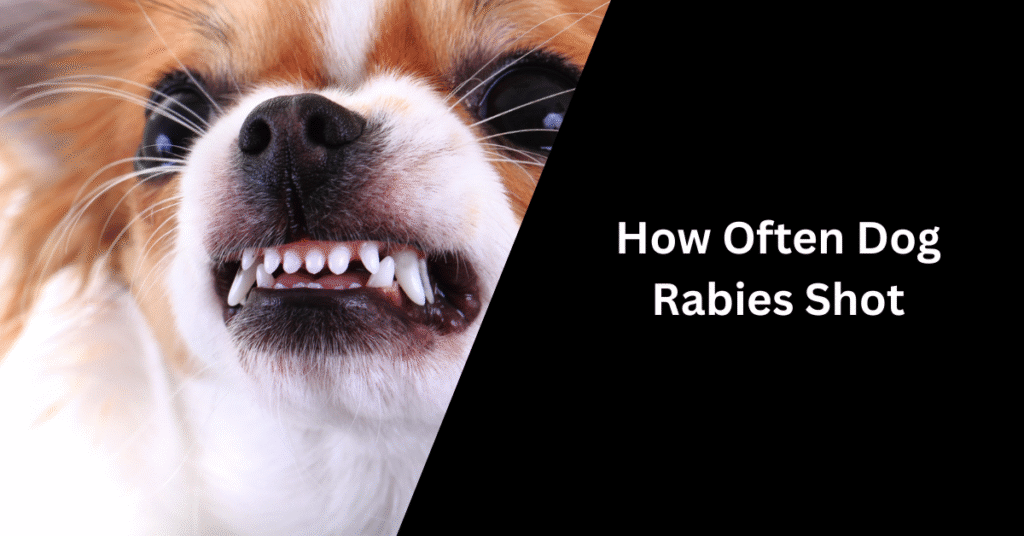A dog rabies shot is needed every 1 to 3 years, depending on the vaccine type and state laws. Puppies receive their first rabies vaccine at 12 to 16 weeks, followed by a booster a year later. After that, dogs get either annual or 3-year vaccines, with compliance required for licensing and travel.
Rabies Vaccine Schedule for Dogs
Dogs require a specific vaccination timeline to maintain protection against rabies. This schedule varies depending on the dog’s age and health status. Regular booster shots ensure long-term immunity.
Initial Vaccination Timing
Puppies should receive their first rabies vaccine between 12 and 16 weeks of age. This timing aligns with the decline of maternal antibodies, which can interfere with vaccine effectiveness if given too early.
Most regions legally require dogs to be vaccinated at or after 12 weeks. Veterinarians often administer the initial shot during a routine checkup at this age. The first vaccine stimulates the immune response but does not guarantee immediate full protection.
Booster Shot Frequency
After the initial rabies vaccination, dogs need a booster shot within one year. This booster confirms and strengthens immunity.
Following the one-year booster, additional rabies vaccinations are typically given every 1 to 3 years. The exact interval depends on local regulations and the type of vaccine used. Some vaccines are approved for a three-year duration, which a vet will consider when scheduling boosters.
Differences by Age Group
For adult dogs with no prior rabies vaccination history, a single initial dose followed by a booster one year later is required. This establishes immunity similar to that in puppies.
Older dogs with up-to-date vaccinations usually continue with routine boosters according to the standard schedule. Dogs with compromised immune systems may require closer monitoring or more frequent vaccinations. Veterinary guidelines adjust timing based on individual health status.
Legal and Regional Requirements
Requirements for dog rabies vaccinations vary widely depending on location. Some areas mandate annual shots, while others allow longer intervals between vaccines or have specific rules for importing pets.
State and Local Laws
In the United States, rabies vaccination laws are set by individual states and often enforced at the county or city level. Most states require dogs to receive their first rabies vaccine by four months of age.
After the initial vaccine, dogs usually need a booster one year later. Following this, many states accept a three-year vaccine, but some still mandate yearly boosters. Failure to vaccinate can result in fines or restrictions on dog ownership.
Leash laws and quarantine requirements may accompany vaccination rules to limit rabies risk in the community. Owners should consult their local animal control or health department for precise regulations.
International Standards
Internationally, countries have diverse policies on rabies vaccination due to varying rabies risk levels. In rabies-free countries like the UK, dogs must have proof of vaccination along with other health certifications for entry.
Countries with endemic rabies, such as parts of Asia and Africa, often require annual shots and strict vaccination proof for pets. The World Organisation for Animal Health (WOAH) recommends at least one rabies vaccine in a dog’s lifetime, but local laws dictate frequency.
Travelers moving pets between countries must follow specific import and export rules, which often include updated rabies vaccines administered within a set time frame, typically 30 days to one year before entry.
Factors Influencing Rabies Shot Frequency
The timing of rabies vaccinations depends on various factors. These include the type of vaccine used and the individual dog’s health and daily activities. Both can significantly alter how often a dog needs to be vaccinated.
Vaccine Type and Duration
Rabies vaccines vary by manufacturer and formulation. Some vaccines provide immunity that lasts for one year, while others are approved for three years.
Veterinarians administer 1-year vaccines initially, commonly for puppies, then switch to 3-year vaccines for adult dogs if local laws permit.
The type of vaccine affects scheduling and booster requirements. It’s important to follow the manufacturer’s guidelines and local regulations.
Table: Common Rabies Vaccine Types
| Vaccine Type | Typical Duration | Common Use |
|---|---|---|
| 1-Year Vaccine | 12 months | Puppies, first dose |
| 3-Year Vaccine | 36 months | Adult dogs |
Dog Health and Lifestyle
Dogs with compromised immune systems or chronic illnesses may need more frequent vaccinations for effective protection. A veterinarian will assess the dog’s health status before recommending a schedule.
Lifestyle factors like outdoor access, contact with wildlife, or travel to high-risk areas also influence vaccine frequency.
Indoor dogs with limited exposure may follow a standard schedule, while dogs in high-risk environments might require boosters sooner.
Owners should inform their veterinarian about any health issues or lifestyle changes to adjust the rabies shot schedule accordingly.
Consequences of Missed or Delayed Rabies Shots
Missing or delaying a dog’s rabies vaccination can lead to serious outcomes that affect the dog’s health and create legal and safety concerns. The risks extend beyond the pet to communities and owners who rely on vaccination laws.
Health Risks to Dogs
A missed rabies shot leaves a dog vulnerable to infection by the rabies virus, which is almost always fatal once clinical symptoms appear. Rabies affects the central nervous system, causing aggressive behavior, paralysis, and eventually death.
Dogs without up-to-date rabies vaccinations may require quarantine or euthanasia if exposed to potentially rabid animals. Early vaccination reduces the chance the dog contracts or transmits rabies.
Vaccination also protects dogs from unknowingly spreading the virus to other animals or humans. Timely vaccination prevents this risk by maintaining effective immunity.
Legal and Public Safety Implications
Many states and countries legally require dogs to have current rabies vaccinations. Failure to comply can result in fines, restrictions, or mandatory quarantine.
If a dog bites someone and its rabies vaccination is not current, the animal may be seized and tested or quarantined, creating potential legal and financial burdens for the owner.
Communities depend on vaccination laws to prevent rabies outbreaks. Delayed shots undermine public health efforts designed to control and eradicate rabies.
Owners should keep vaccination records updated to avoid penalties and help ensure public safety.
Vaccination Best Practices
Maintaining accurate vaccination records and working closely with veterinary professionals are essential for effective rabies prevention. Both elements ensure timely immunizations and compliance with local animal health regulations.
Record Keeping for Vaccinations
Detailed records of each rabies vaccination are crucial. These should include the date of administration, vaccine brand, lot number, and the veterinarian’s name.
Owners should store vaccination certificates safely and update them immediately after each shot. Digital records can also help track booster schedules efficiently.
Proper documentation supports legal proof of vaccination. This is necessary for travel, boarding, or participation in certain events. It also aids veterinarians in monitoring the dog’s vaccination history to avoid unnecessary or missed doses.
Coordinating with Veterinary Professionals
Regular communication with a veterinarian ensures the dog receives rabies shots at appropriate intervals based on local laws and the dog’s health status.
Veterinarians assess the dog’s immune response, age, and lifestyle before recommending vaccine timing. They can alert owners to changes in recommended vaccination frequency or new vaccine options.
Scheduling appointments in advance for boosters prevents lapses in protection. Veterinarians also provide guidance on vaccine side effects and proper post-vaccination care, ensuring the dog’s safety and health.
Conclusion
In conclusion, a rabies shot depends on local laws, vaccine type, and your veterinarian’s guidance. In most places, puppies get their first rabies shot around 12–16 weeks old, followed by a booster after one year. After that, many areas require either an annual vaccination or a three-year rabies shot, depending on the vaccine used and regulations in your region.
I’ve loved dogs all my life and have cared for many different breeds over the years. Here, I share simple tips, stories, and helpful advice for all dog lovers. Whether you’re a new pet parent or a lifelong dog fan, you’ll find something useful and fun on my site.


